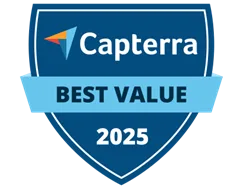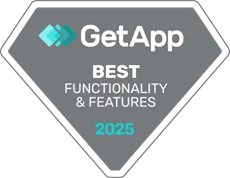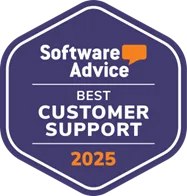Author: Michael Patti
Long gone are the days when it was enough for your association to simply choose a software solution, set it up, and implement it into your workflow. To keep up with current trends and get the most out of your tools, you need to continuously iterate on your approach, strategically investigating new systems, features, and settings that can help you deliver value.
This guide will help you identify potential technology gaps your association may have and how you can close them. That way, you can streamline internal processes, save time, and improve the member experience.
1. Disconnected Systems
You likely have a tech stack filled with different systems, such as a customer relationship management platform (CRM), event management software, and financial management solutions. When these systems aren’t connected, it’s difficult to share data between them, preventing you from gaining a unified view of your members and operations. Plus, manually entering data from solution to solution introduces the risk of human error.
How to Close This Gap
- Audit your data. The first step in implementing proper data hygiene is reviewing your systems to determine what data you have and where it’s stored. Once you understand where your data lives, you can start conceptualizing which disparate data points need to flow between platforms. For example, you may have member contact information in your CRM and event attendance history in your event management software. When these systems connect, you can more easily invite members interested in events to future opportunities.
- Adopt a cloud-based system. Cloud-based CRMs and association management systems (AMS) create a single source of truth for your team, simplifying collaboration. Updates made by one department automatically sync across all other departments, so everyone has the most up-to-date information possible.
- Investigate integrations. If you’re adopting new tools, look for solutions that integrate with your existing software. Integrations eliminate the need for manual data entry and ensure your tools work together seamlessly. For instance, you may set up an integration between your event platform and accounting software to automatically input event costs into your budget-to-actual report. Results at Hand has integrated our event management platform with Novi AMS to ensure seamless data sync, faster check-ins, attendance tracking, and more!
2. Lack of Member Engagement
As Strategic Association Solutions’ association strategy guide explains, “All goals should ultimately put the member experience at the forefront. Internal improvements are sometimes necessary to better serve members, but you should also have goals that directly relate to members and their experiences with your association.” If member engagement is low, you could probably be better leveraging technology to improve the member experience.
How to Close This Gap
- Segment your member base. Sort members into relevant groups within your CRM or AMS based on shared characteristics. These groups allow you to send targeted messages that align with members’ specific needs and interests. For example, you may want to create segments for first-time attendees, exhibitors, speakers, etc. within your Results at Hand mobile event app. This way, you can easily send relevant notifications and messages to different groups of people at your event and craft a more personalized event experience.
- Personalize communications. In addition to segmentation, you can also personalize your communications by pulling member data from your CRM or AMS and including it in your messages. Address members by name, reference their engagement history, and use their preferred channels, such as email, direct mail, or text message, to show you’re committed to building individual relationships with them.
- Invest in a community platform. Using a platform specifically designed to build community provides a space for members to engage with each other online and form a deeper connection to your organization. Look for a solution with features like a member directory, discussion forums, and social feeds.
3. Limited Staff Capacity
Your staff is likely busy communicating with members, developing programming, and planning enriching events. However, if you can’t commit to technology optimization, you might not get the most out of your systems.
How to Close This Gap
- Prioritize targeted training. You don’t have to transform your entire technology strategy all at once. Instead, narrow your focus to your most pressing needs and goals. Then, research how to improve your technology use in these areas, and train your team on these tactics. For example, if you’re looking to create more advanced data reports within your CRM, you may find a video about this topic in the provider’s resource library and share it with the appropriate team members.
- Leverage automation. Automation streamlines manual tasks, saving your team time that it can dedicate to more mission-critical areas. Double the Donation’s fundraising automation guide explains several use cases for automation, including recurring donation processing, matching gift auto-submission, and supporter segmentation.
- Work with a technology consulting firm. Consider outsourcing your needs to a dedicated firm. Look for a provider with association-specific technology services, such as association technology strategy development, AMS implementation, and support.
4. Cybersecurity Issues
Members trust you with their sensitive information, such as mailing addresses and payment details. Without robust security measures, you put this data at risk and may end up losing members’ trust.
How to Close This Gap
- Implement user permissions. Not everyone on your team needs access to all of your association’s data. By limiting access with role-based user permissions, you can protect sensitive information from getting into the wrong hands or leaking.
- Use multi-factor authentication. When team members log into your systems, they should have to prove they’re authorized users with another form of authentication. This setting makes it difficult for hackers to enter your solutions and access restricted information.
- Encrypt sensitive data. When sharing and storing sensitive information, take care to encrypt it. That way, if this information does get into the wrong hands, they won’t be able to easily decipher and leak it.
5. Static Tech Strategy
New technologies are constantly emerging. If you don’t plan ahead to seek out and implement these solutions, you’ll fall behind other organizations in your field.
How to Close This Gap
- Assign a technology steward. To keep your team informed about new technologies, assign the role of technology steward to a member of your team. This person will be responsible for researching tech trends and reporting on them to the rest of your organization so you can discuss and implement relevant solutions.
- Develop an AI policy. While many organizations are interested in leveraging AI, 76% of nonprofits don’t have an AI strategy, and 80% don’t have an AI acceptable use policy. Harnessing this trend requires discovering how AI best fits into your organization’s workflow, addressing ethical considerations like data privacy and bias, and maintaining transparency with members about how you’re using their information to power AI.
- Set aside funds for new tools. Although you may not be able to anticipate exactly when new technology will emerge, you can prepare for it through responsible financial management. Budget for potential new tools so you have enough funds to invest in and test out new solutions as they become available to your organization.
Ultimately, your technology strategy will depend on your association’s specific goals, needs, and budget. By keeping those aspects in mind and proactively addressing the concerns in this guide, your association can build a robust and useful tech infrastructure. To take your tech strategy to the next level of comprehensiveness and quality, partner with an association technology consultant.
 Author: Michael Patti
Author: Michael Patti
Michael Patti is the Vice President of Technology of Strategic Association Solutions (SAS), an accounting, technology, and creative services consultancy. In his role, Michael is responsible for developing, implementing, and maintaining association management systems (AMS), content management systems (CMS), Microsoft M365 environments, and computing hardware.
Michael leads a team of systems analysts, programmers, UI experts, and M365 administrators to craft tightly integrated solutions for our clients. SAS chooses best-of-breed platforms, such as WordPress CMS, re:Members AMS, Microsoft SharePoint, Cadmium Elevate LMS, and Higher Logic community and marketing platforms.
Michael began his career as a website developer for a non-profit in Washington, D.C., and then started working for a Chicago-based AMC in 2000. When that AMC was acquired by Kellen in 2015, Michael was promoted to director of client technology and eventually became the Vice President of Technology for Kellen.
Michael holds BAs in sociology and music from Knox College. In his spare time, he enjoys playing guitar and taking long-distance bike rides in and around Chicago.



